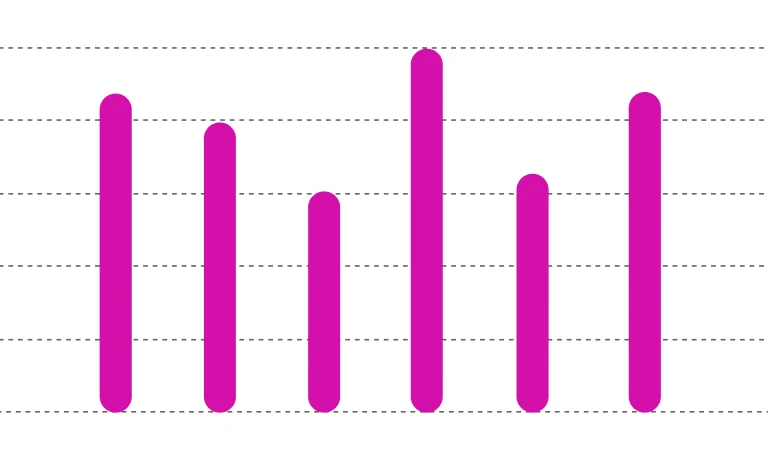A compelling job description is vital to attracting top quantitative analysts since it's often their first interaction with your organization. A clear and detailed description shows your company values specificity and accuracy, traits that resonate with this candidate pool.
But many organizations struggle to write quantitative analyst job descriptions because they don’t know which skills to include or how to articulate them succinctly. Ever-evolving technical requirements for these roles add to these challenges.
Below, we explore key skills to look for in quantitative analyst candidates, best methods for writing effective job descriptions for this role, and pitfalls to avoid.
Table of contents
- What is a quantitative analyst?
- Key skills to look for in a quantitative analyst
- How to write an effective quantitative analyst job description
- Quantitative analyst job description template
- 4 things to avoid when writing a job description for quantitative analysts
- Next steps: Attracting and assessing quantitative analyst candidates
- FAQs
- Attract and hire talented quantitative analysts with skills-based job descriptions
What is a quantitative analyst?
Quantitative analysts, often called "quants," are professionals who apply advanced mathematical and statistical techniques to analyze data, solve complex problems, and make informed decisions, typically in fields like finance, risk assessment, or scientific research.
Key skills to look for in a quantitative analyst
When writing your quantitative analyst job description, consider these five key skills.
Strong analytical skills: Shows a deep understanding of mathematical and statistical concepts through problem solving and data analysis
Programming proficiency: Uses programming languages like Python, R, or MATLAB to manipulate data, develop models, and automate tasks
Financial knowledge: Makes informed investment decisions based on knowledge of financial markets, instruments, and risk-management strategies
Quantitative modeling: Creates and applies mathematical models to solve real-world problems
Communication skills: Translates quantitative strategies into simple business advice for those without tech backgrounds
The best insights on HR and recruitment, delivered to your inbox.
Biweekly updates. No spam. Unsubscribe any time.
How to write an effective quantitative analyst job description
Resume and education requirements don’t improve your job descriptions because they don’t fully capture an ideal candidate’s skills. In fact, degree inflation shrinks your talent pool to only those quantitative analysts with college or university backgrounds – regardless of their actual skills.
A well-crafted job description for quantitative analysts makes the required skills and abilities the central focus. Follow these steps to write an effective, skills-based job description for this role.
Define and detail skill requirements
Quantitative analyst roles require a unique blend of hard and soft skills. Conduct a skills-gap analysis to discover the gap between the existing quantitative skills in your organization and the skills needed to reach your goals.
With technological advancements, proficiency in machine learning algorithms and cloud computing platforms has become increasingly essential for quantitative analysts. Keep your requirements updated instead of relying on old job descriptions and show candidates exactly what you’ll expect of them.
Engage and attract
Make the job appealing by showcasing your good company culture – emphasizing values that align with analytical precision, collaborative work environments, and dynamic team interactions. Stress growth opportunities specific to quantitative research, showing your commitment to candidates’ specialized career development.
Use inclusive language
Use inclusive language, avoiding biased terminology, to encourage a diverse pool of candidates to apply. You should also express your commitment to diversity and clearly state that your company is an equal opportunity employer. This will help you comply with employment laws and regulations to engage in fair hiring practices.
Quantitative analyst job description template
Here's a template that can help you craft your own job description.
Company introduction
In this section, speak to your company’s culture, industry, size, and mission statement. You should provide a snapshot of what your organization does and its core values.
Also, emphasize any notable achievements, awards, or recognitions your company has received. Quants thrive on data and research. Information about your company's achievements and market impact shows them the availability of quality data and research challenges they can expect.
Benefits of working with [your company]
Here, you can speak about your company’s perks and unique offerings to help candidates envision what it's like to work there.
Consider whether your company provides work-life balance, opportunities for continuous learning and development, and intellectually stimulating projects.
Quantitative analyst job brief
[Company name]
Job title: [For example, Junior Quantitative Risk Analyst, Quantitative Risk Analyst, or Senior Quantitative Risk Analyst]
Reports to: [For instance, Senior Quantitative Risk Analyst, Head of Risk Management, or Chief Risk Officer]
Position type: [Full-time, part-time, on-site, remote, or hybrid]
[Salary and benefits information]
Quantitative analyst responsibilities
Analyze large datasets to extract meaningful insights and trends.
Develop mathematical and statistical models for financial or scientific purposes.
Evaluate and quantify financial risks, e.g., through complex risk models.
Create and optimize algorithms for trading, forecasting, or data processing.
Conduct research on financial markets and economic conditions to inform decision-making.
Manage and fine-tune investment portfolios to maximize returns while minimizing risks.
Create detailed documents or presentations that summarize findings and insights derived from data analysis and quantitative modeling for non-technical stakeholders.
Requirements, qualifications, and training required
[Specify required education level or degree(s) here (consider showing acceptance of equivalent experience)]
[Specify required years of experience here]
[Specify the software tools, programming languages, and data analysis platforms in which candidates should be proficient]
4 things to avoid when writing a job description for quantitative analysts
Avoid the following pitfalls to attract the right candidates:
1. Vague terminology
Avoid ambiguous language that might mislead or confuse potential candidates.
For example, don’t ask for “familiarity with relevant tools” without specifying tools like Python, MATLAB, or specific financial modeling software. Similarly, don’t include “strong analytical skills” without detailing expected analytical tasks like time-series forecasting and algorithm development.
2. Excessive requirements
Avoid overwhelming job seekers with an excessive list of qualifications and skills. Focus on the core essentials to widen your candidate pool.
For instance, very few quantitative analysts will be high-level experts in various statistical software platforms all at once. So, by requiring this expertise, you'll scare away otherwise qualified candidates.
3. Lack of realism
Be realistic about the qualifications and experience required. Avoid setting overly high standards that may deter qualified candidates.
Too many modern-day job descriptions for quantitative analysts require 3-8 years of job experience and an advanced degree in a quantitative discipline. But these overly high standards can discourage qualified candidates from applying. A self-taught algorithmic trader, for example, can rival formally trained quants through hands-on platform experience and results.
4. Exclusion of soft skills
Don't solely emphasize technical skills. Quantitative analysts also need strong communication, teamwork, and problem-solving skills. Including these soft skills in your descriptions helps attract well-rounded candidates who can seamlessly integrate into teams and communicate complex ideas effectively.
Next steps: Attracting and assessing quantitative analyst candidates
Once you've crafted a comprehensive job description, advertise on industry-specific job boards, university career centers, and specialized forums to attract candidates.
After you’ve got a strong pool of applicants, you must assess their qualifications. Using the right approach is crucial to ensure you're selecting the best talent.
For example, TestGorilla’s library of multi-measure talent assessments includes a variety of pre-employment tests. When combined, these tests provide comprehensive overviews of candidates to ensure you pick the one who’s the right fit for your role and organization.
Role-specific tests, including our Statistics and Probability test, assess numerical reasoning skills and knowledge of core concepts for statistical data analysis.
Cognitive ability tests, including our Problem Solving test, assess analytical skills.
Programming skills tests, like our Python Coding test, evaluate a candidate’s coding skills.
Our Communication Skills test assesses communication competence skills.
Personality tests, including our DISC Personality test, reveal candidates’ values, motivations, and behaviors.
FAQs
How can I make my job description more appealing?
Emphasize essential qualifications like a quantitative analysis background, knowledge of programming languages, and statistical software proficiency.
How can I create a job description that attracts entry-level and experienced quantitative analysts?
To attract diverse candidates, specify qualifications and experience in separate sections: “Entry-Level” for newcomers and “Preferred Experience” for seasoned applicants.
How can I optimize keywords for better search results?
Use industry-specific keywords, like “time-series forecasting,” naturally throughout the description to enhance visibility on job boards and websites.
Attract and hire talented quantitative analysts with skills-based job descriptions
Crafting an effective job description for your quantitative analyst role is critical for attracting the right candidates. This process involves understanding the role’s key skills, implementing best practices, and avoiding common pitfalls.
By following our comprehensive template, which emphasizes not only the role's responsibilities but also your company culture and growth opportunities, you can attract the best talent.
Once you’ve gotten qualified quantitative analysts to apply, begin assessing them efficiently and effectively with TestGorilla’s 300+ assessments.
Want to learn more? Create a free account, take our product tour, or schedule a live demo to hire skilled quantitative analysts today.
You've scrolled this far
Why not try TestGorilla for free, and see what happens when you put skills first.















